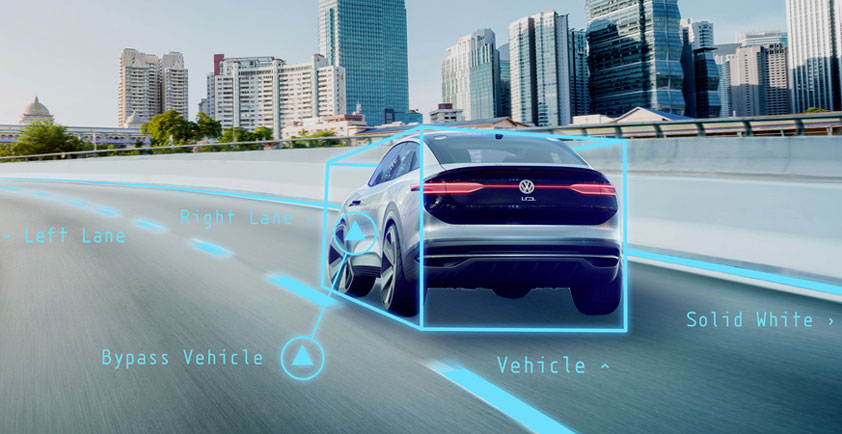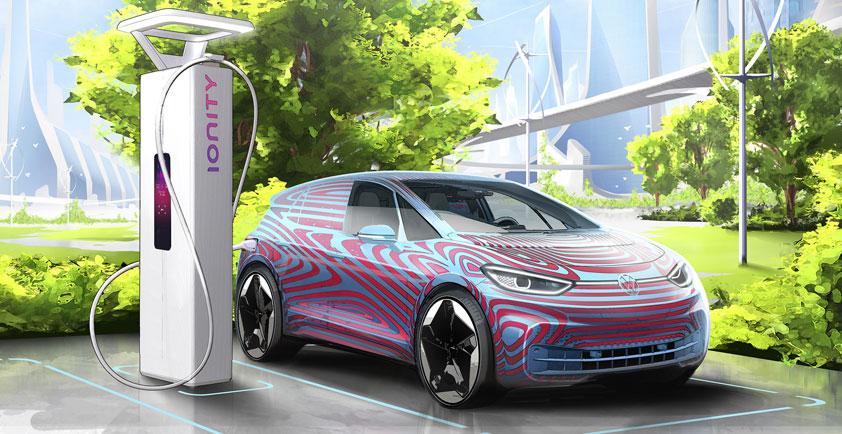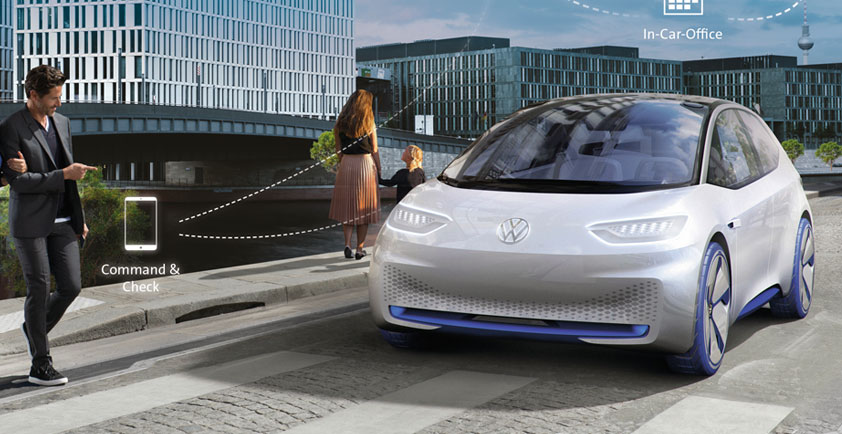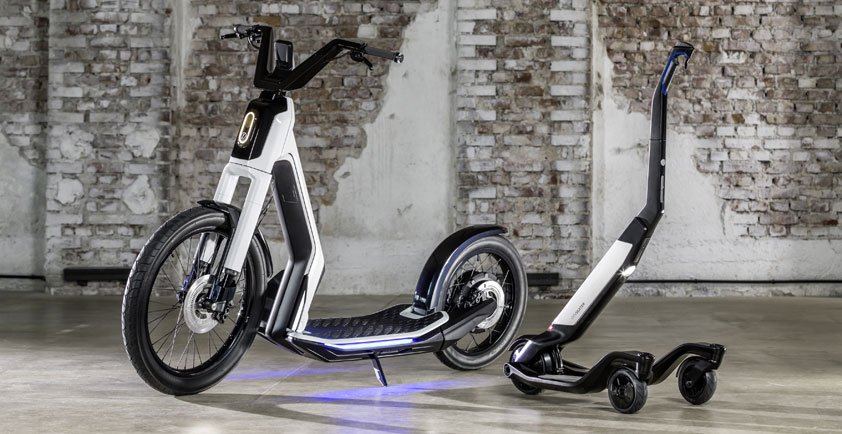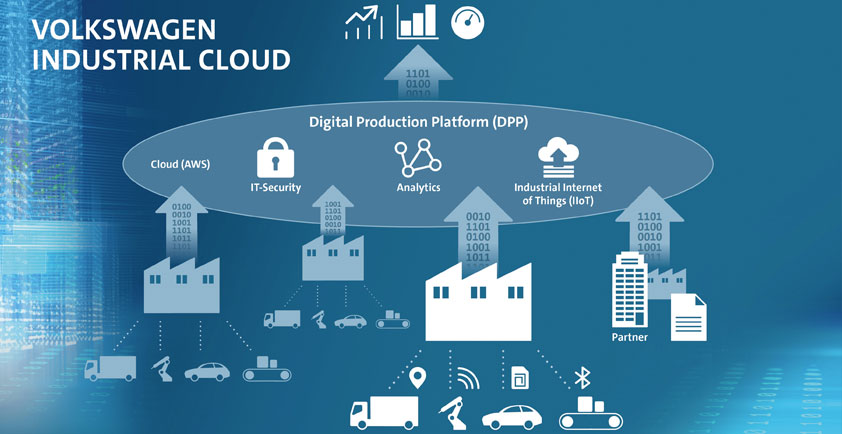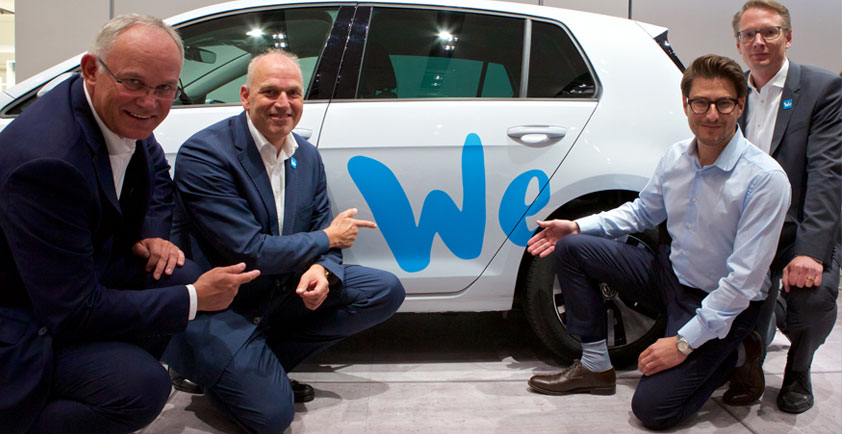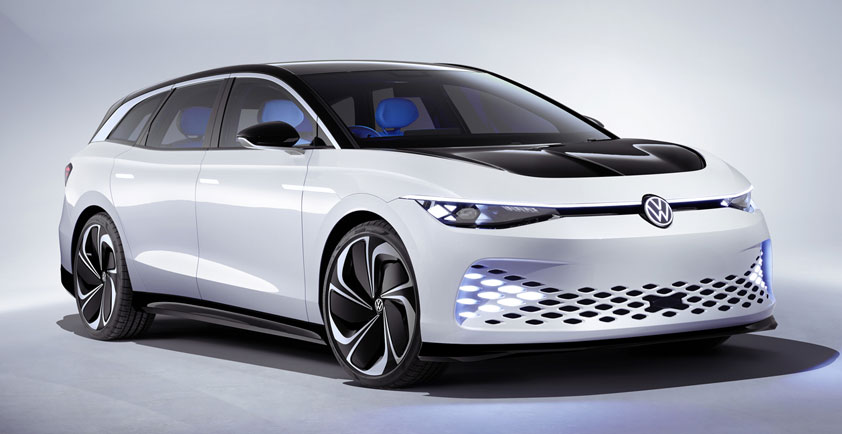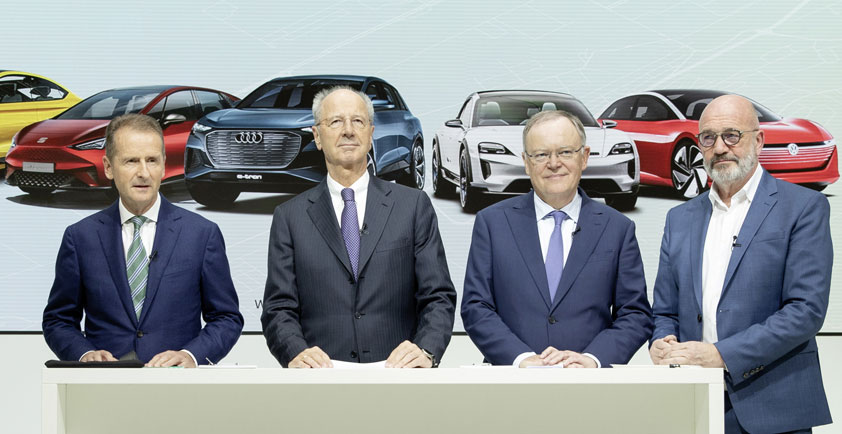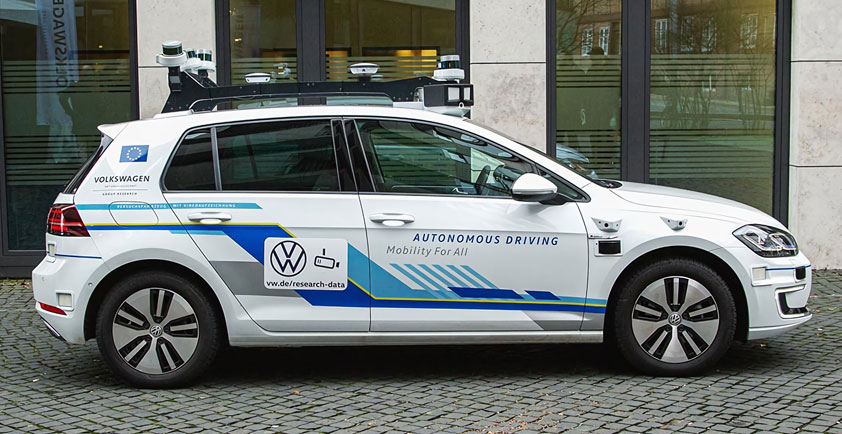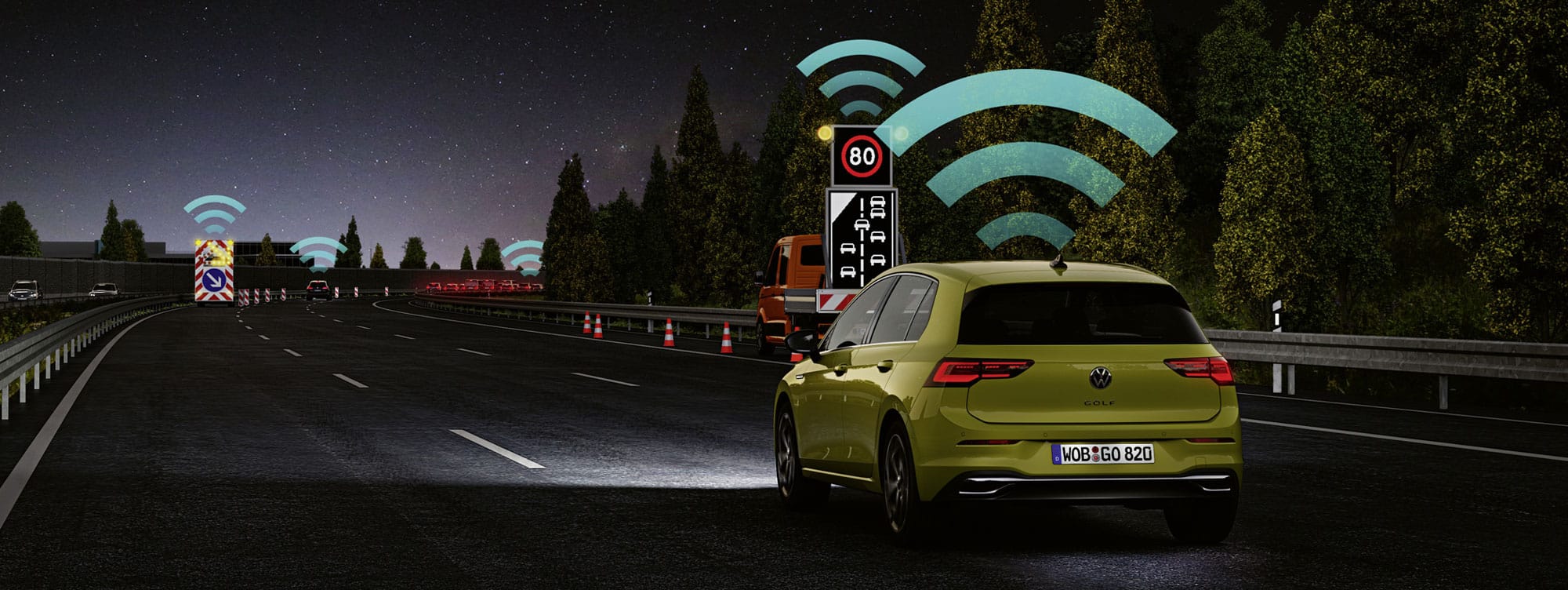
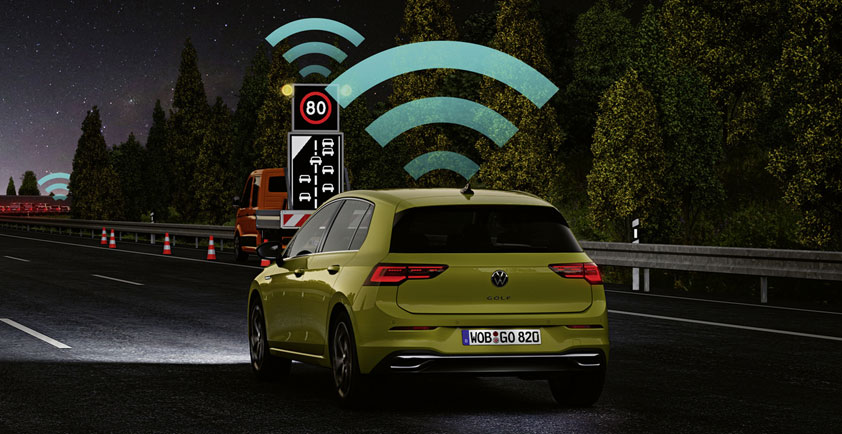
WORLD PREMIERE FOR THE NEW GOLF: DIGITALISED, CONNECTED, AND INTELLIGENT
>> Digital offensive. Displays and controls are consistently digitalised so their functions are self-explanatory
>> Safety offensive. The Golf is the first Volkswagen with Car2X communication fitted as standard
The Golf is the most successful European car for more than four decades. A new chapter in the history of this best-seller begins today, 24 October 2019, with the world premiere of the eighth Golf – digitalised, connected, and intuitive to operate. Never before has a Golf been so progressive. With hybrid versions launched at the same time, it is electrifying the compact class. Its digital interior enables a new dimension of intuitive operation. Speeds of up to 210 km/h are possible with assisted driving. It is the first Volkswagen to use swarm intelligence from traffic via Car2X, meaning it can warn against hazards on an anticipatory basis. Its world premiere takes place in Wolfsburg, where the Golf was invented, and where it has been built and refined for the last 45 years. The new Golf will be available on the market in December.
“Over the course of seven generations, the Golf has impressed more than 35 million customers. The entire automobile industry expects a new Golf to set the standard”, explained Dr. Herbert Diess, Chairman of the Board of Management of Volkswagen AG. In terms of its technology, the Golf is making the greatest leap forward since its debut. Ralf Brandstätter, Chief Operating Officer of Volkswagen Passenger Cars: “This car is completely new. But of course, a Golf always remains a Golf. Because the underlying concept is timeless. This car has defined our brand over decades. The Golf has consistently made new technologies available for everyone.”
It is a fact that the new Golf makes sustainable mobility accessible to many people. What’s more, with this Golf Volkswagen is moving to digitalised, self-explanatory operation. Klaus Bischoff, Head Designer at Volkswagen: “In a world where complexity is ever-increasing, the new Golf allows the driver to operate the vehicle intuitively.” Practically all displays and controls are digital: the new instruments and online infotainment systems meld together into a display landscape featuring touch buttons and touch sliders. A windshield head-up display is optionally available to further enhance the range of information available.
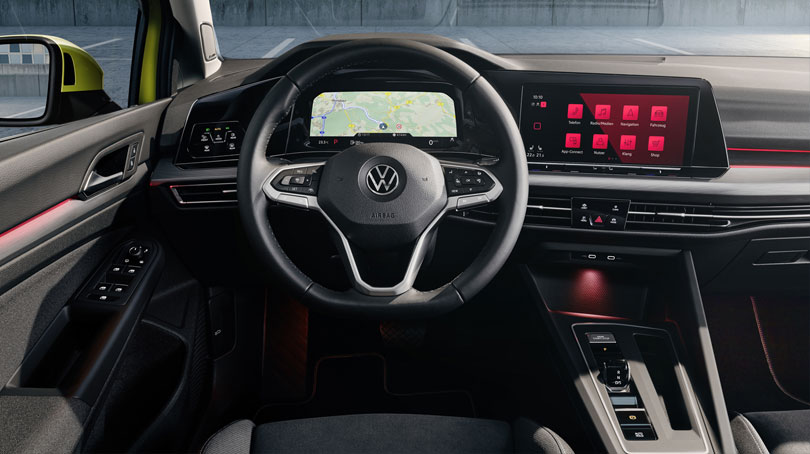
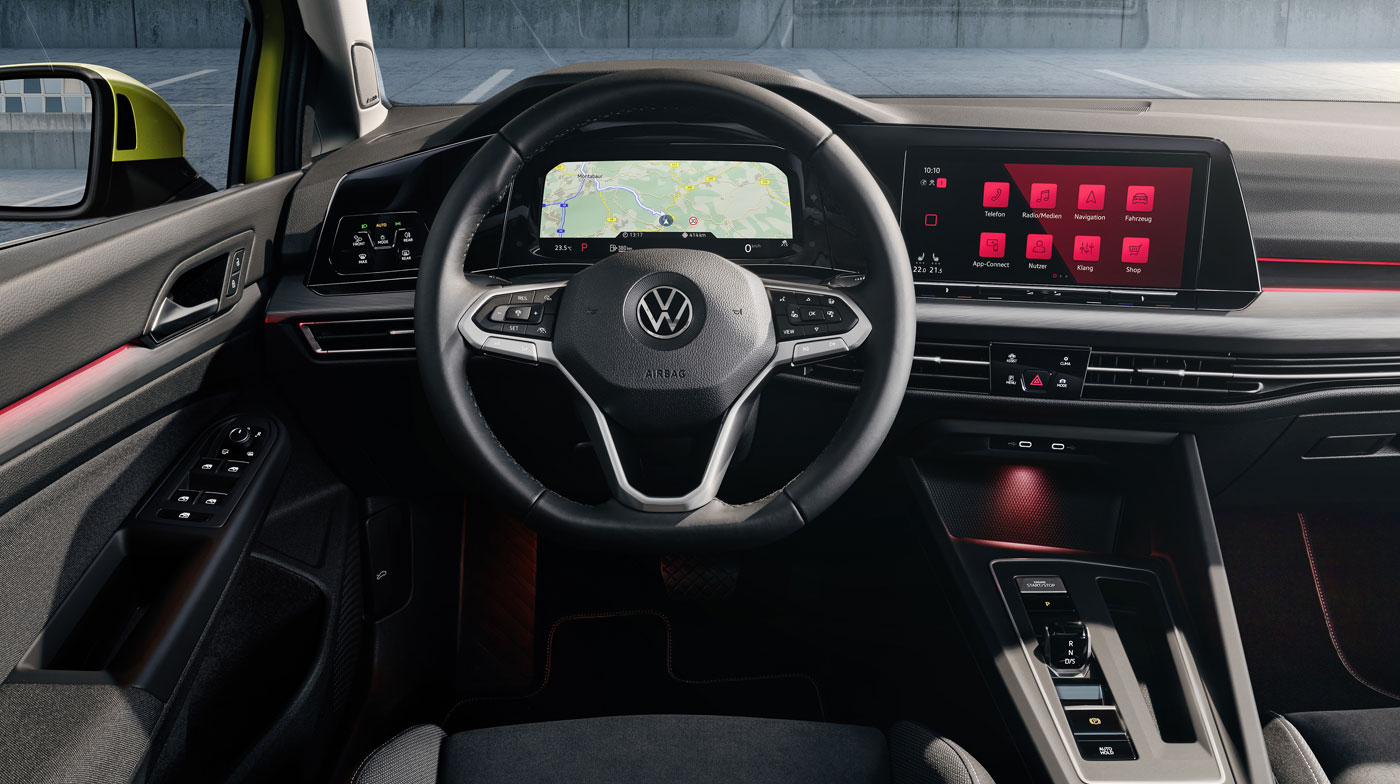
Highlight of the new Golf – The Digital Cockpit
The new Golf will shortly come to market with a revolutionary cockpit that is clearer, neater, completely digitalised, and connected online, and that will make operating this bestseller more intuitive than ever.
The Digital Cockpit, which comes as standard, includes the instrument cluster, an infotainment system, and a multifunction steering wheel. Together, these form the first functional level, in which virtually all of the displays and controls are digital. Touch sliders enable quick and intuitive access to temperature and volume controls, while a touch island under the infotainment system also provides direct access to additional air conditioning functions, the assistance systems, and – depending on the equipment included – driving modes and parking assistants. In a second touch island, the light and vision functions have also been repositioned and brought together: the light, along with the windscreen and rear window heating, is now operated using a digital panel arranged higher up on the dashboard to the left of the instruments, even further improving the brand’s characteristic straightforward drive experience.
A high-end cockpit: the optional Innovision Cockpit is now also available in the Golf
It’s possible to enhance the digital driver’s workplace even further; in combination with the 10-inch Discover Pro top navigation system, the Innovision Cockpit offers an even larger range of functions. On request, a windscreen head-up display will be added to create the ideal cockpit, with information such as speed, navigation information, etc. being projected into the driver’s field of vision.
This advanced functionality is also evident in the centre console, which is now clearer than ever – particularly with the inclusion of the shift-by-wire gear knob for the automatic dual clutch gearbox (DSG), which is significantly smaller than previously. The theme continues to flow across the new roof console, where operation has also been digitalised. Tilting and sliding panoramic sunroof example (optional): just swipe your finger back or forward over a slider, to open and close the transparent roof. It doesn’t get any simpler or more logical than this.
Intuitive operation in the Golf can also be supported by new, natural voice control on request. The system is simply activated by saying “Hello Volkswagen” or pressing the voice button on the steering wheel. The Golf reacts to intuitive voice commands such as “Take me home” (navigation) or “I’m cold” (automatic air conditioner). The new, digital microphones, mean that not only is voice recognition and voice quality (for phone calls) perfect, but they can also locate the person who is speaking (driver or front passenger) and respond accordingly, for example by identifying which interior zone’s temperature needs adjusting.
Digitalisation opens up the opportunity for each driver to adapt the Golf exactly to their own taste. The customised settings can be saved in the vehicle and in the cloud, so they are still available even with a change of driver or vehicle. These settings include (depending on the equipment included) the Digital Cockpit and Innovision Cockpit displays, the seat position, settings for exterior mirrors and air conditioning system, the practically stepless control of the ambient lighting (up to 30 colours) and the Coming Home and Leaving Home functions.
Connectivity via the cloud is enabled by an online connectivity unit (OCU) with an integrated eSIM, to which all infotainment systems in the Golf are coupled as standard. The OCU is also the interface with the ever-growing range of online-based functions and services from We Connect (with no time-related use restrictions as standard) and We Connect Plus (time-limited use is free of charge in Europe). In addition, the optional We Connect Fleet service has been developed for companies, for digital fleet management.
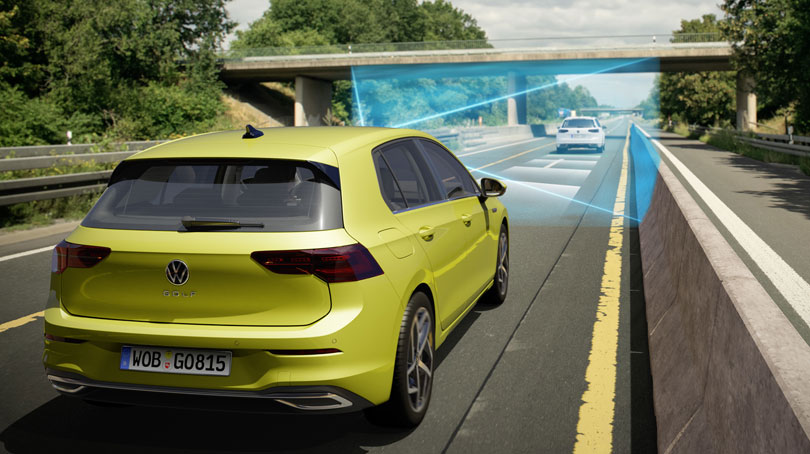
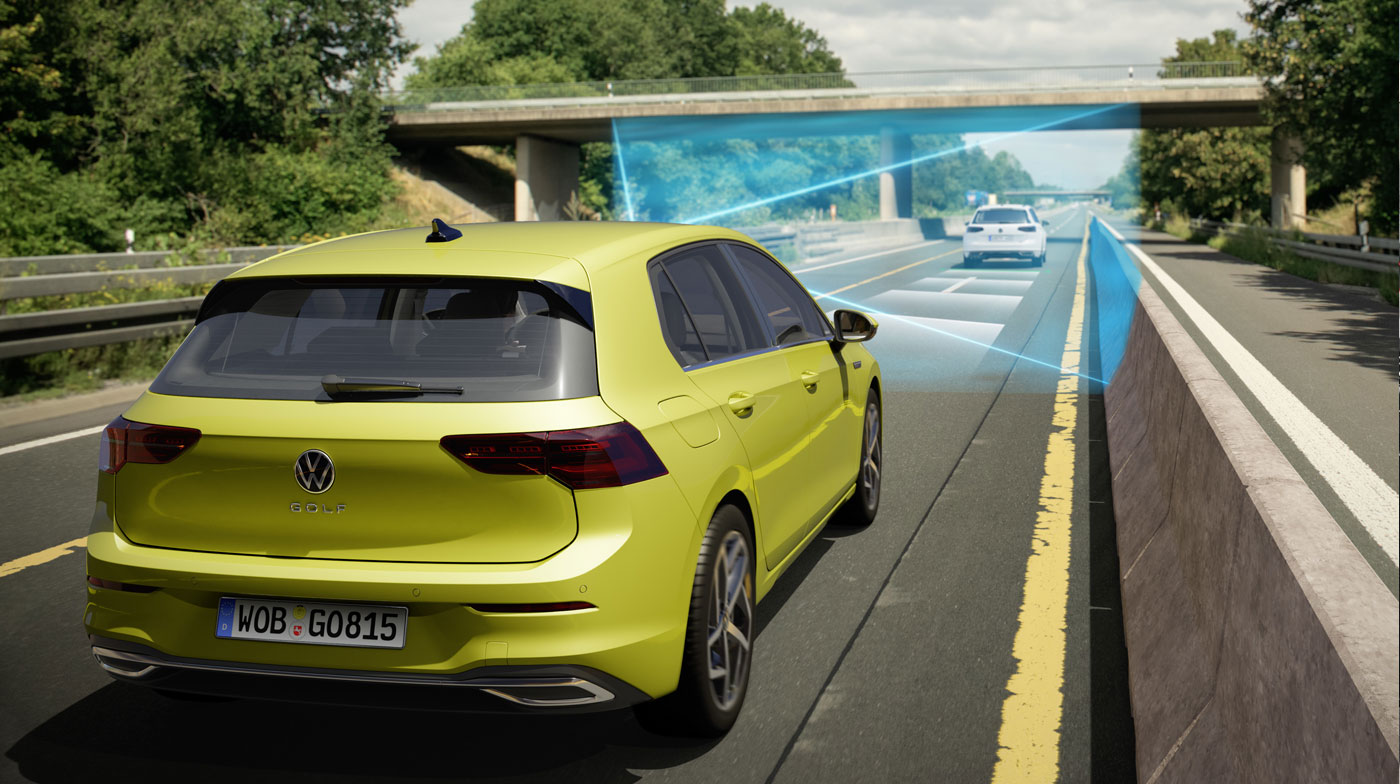
Car2X, Travel Assist and IQ.LIGHT in a Golf for the first time
Car2X guarantees more safety. Car2X communication means that the Golf01 is the first Volkswagen to communicate with other vehicles and traffic infrastructure in the vicinity to exchange information relevant to the traffic situation, within a radius of up to 800 metres. This information is exchanged within milliseconds. Thanks to the application of a harmonised Car2X standard (Wi-Fi p/ITS G5) within the European Union (EU) that is valid for all manufacturers, it is possible to transfer information between vehicles of all brands as well as the infrastructure within all EU member states. This “common language” is a crucial requirement to cut the number of road traffic accidents throughout all countries. Thanks to Car2X, drivers are notified and warned of local traffic hazards.
Car2X in detail: The traffic hazard alert function uses Car2X communication to notify and warn drivers about local hazards. Car2X communication registers the following scenarios: Accidents, broken down vehicles, tail ends of traffic jams, roadworks, emergency braking and emergency service vehicles. In the case of emergency service vehicles, for example, the hazard alert makes it possible to provide drivers with targeted, specific information about the distance and direction of approaching ambulances, fire service vehicles, police vehicles, etc. equipped with Car2X systems, thus allowing drivers to react in good time. The system can also help to reduce risks, for instance caused by emergency service vehicles running a red light during emergency deployments. Emergency service vehicles’ response times can also be cut, for instance thanks to vehicles forming an emergency corridor in good time. Vehicles that have broken down or been involved in an accident can also highlight the potentially hazardous situation at an early stage by issuing a virtual warning triangle (displayed in other vehicles’ cockpit). The electronic brake light represents an additional safety feature: if vehicles driving further ahead of the Golf brake sharply, the brake lights of the vehicles behind are automatically activated. As a result, all vehicles behind and their drivers are able to react significantly earlier thanks to Car2X. It is clear that targeted visual and audible driver support in hazardous situations using direct Car2X communication in the Golf can prevent accidents – and that represents a milestone on the path to accident-free driving.
Travel Assist. The new Travel Assist feature in the Golf enables assisted driving up to 210 km/h. In this process, the system relies on systems including ACC Adaptive Cruise Control (longitudinal guidance) and Lane Assist lane keeping system (latitudinal guidance). Travel Assist is activated using the multifunction steering wheel. For legal and safety-relevant reasons drivers must permanently monitor the system – for this purpose, they must have at least one hand on the steering wheel. Thanks to new capacitive sensor technology in the steering wheel, it is sufficient if drivers merely touch it. However, if they let go of the steering wheel for more than 15 seconds, visual and audible warning signals and a braking jolt are issued and implemented. The driver must react by this point at the latest and touch the steering wheel, otherwise Emergency Assist is activated and the Golf is brought to a stop.
ACC with predictive speed detection. The latest generation of Adaptive Cruise Control in the Golf is predictive. In this process, the system calculates the position of the Golf based on route and GPS data from the navigation system to lower its speed before reaching bends, roundabouts, junctions, speed limits and built-up areas. At the same time, ACC accesses the Dynamic Road Sign Display via the front camera and adjusts the speed as soon as a limit has been detected. The highest ACC development stage will also feature Traffic Jam Assist.
Front Assist. Front Assist offers new functional scopes. The area monitoring system operating on the basis of a radar sensor and in conjunction with the front camera warns and brakes in emergency situations in the event of an insufficient distance to the vehicle ahead – using the City Emergency Braking System and Pedestrian Monitoring, even at very low speeds in built-up areas. This range of functions is now enhanced by Cyclist Monitoring, swerve support and – for the first time in a Volkswagen – oncoming vehicle braking when turning function.
Oncoming vehicle braking when turning. When the vehicle turns left, the Golf featuring oncoming vehicle braking when turning automatically brakes the vehicle to a stop (while simultaneously emitting an audible and visual warning), providing there is an oncoming vehicle approaching on the lane the vehicle is intending to cross. Depending on the speed at which both vehicles are travelling, the oncoming vehicle braking when turning function can prevent an accident or mitigate the consequences within system limits.
IQ.LIGHT – LED matrix headlights. Volkswagen will offer the new Golf01 with three different LED headlight versions. For the very first time, the top-of-the-range version will feature particularly powerful IQ.LIGHT – LED matrix headlights in the compact vehicle category. A similar version of the system had been introduced for the first time in the current Touareg before it was transferred to the new Passat. The driver switches on the system using Dynamic Light Assist. Using 22 LEDs per each headlight matrix module, it activates up to ten different, partly interactive light functions and projects them onto the road surface, depending on the Golf model. The sliding turn indicator function of the IQ.LIGHT LED matrix headlights represents a further feature that has been integrated into the Golf for the very first time. The sliding turn indicator function has a positive effect on active safety as a result of its striking looks.



